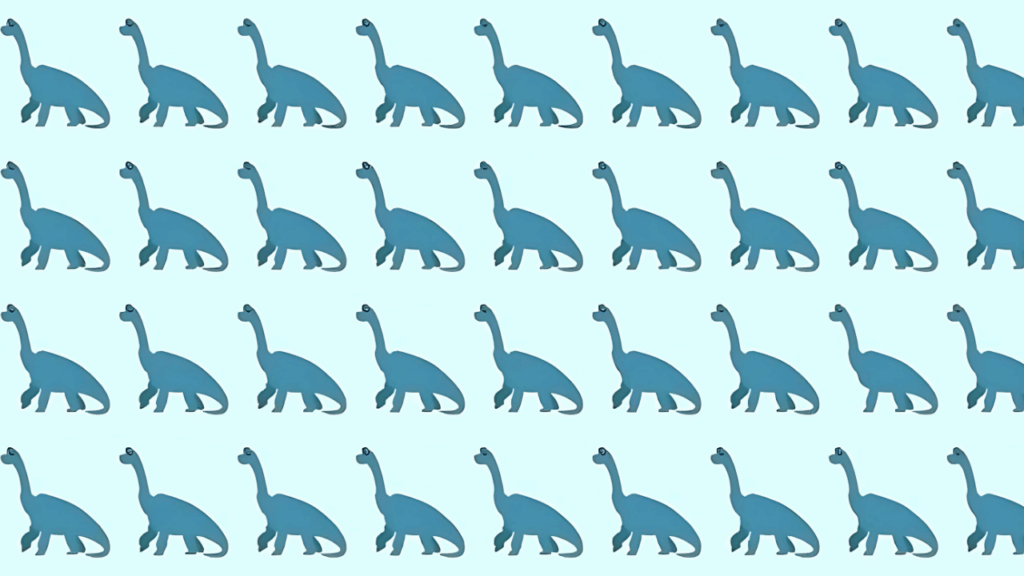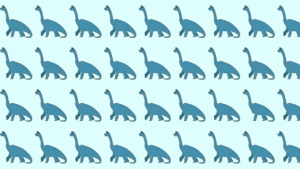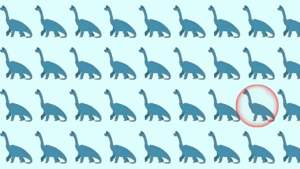
Optical illusions have fascinated humanity for centuries, challenging our perception and revealing the quirks of our brains. From ambiguous images to hidden figures, these visual puzzles entertain, perplex, and sometimes even teach us about how we see the world. In this article, we dive into a captivating optical illusion that conceals a unique dinosaur waiting to be discovered. Can you find it fast? Join us on a 1500-word journey through the science, history, and fun of optical illusions, with tips to uncover the elusive prehistoric creature hidden within this particular puzzle.
The Allure of Optical Illusions
Optical illusions exploit the brain’s tendency to make assumptions about what we see. Our visual system, while remarkable, is not flawless. It relies on patterns, context, and prior knowledge to interpret the world, often leading to misinterpretations. Illusions like the one hiding a dinosaur play with these processes, creating images that can be seen in multiple ways or conceal elements in plain sight.

Why We Love Them
-
Mental Challenge: Optical illusions test our cognitive skills, forcing us to think beyond the obvious.
-
Entertainment: They’re fun for all ages, from kids spotting animals to adults decoding complex patterns.
-
Learning Opportunity: Illusions reveal how our brains process visual information, offering insights into psychology and neuroscience.
This particular illusion, featuring a unique dinosaur, has gone viral for its clever design. It’s not just a random shape—it’s a carefully crafted image that rewards sharp eyes and patience. Let’s explore how to find it and why it’s so tricky.
The Dinosaur Illusion: What to Look For
The optical illusion in question is a monochromatic or two-tone image, blending abstract shapes, lines, and textures. At first glance, it might resemble a random pattern, a landscape, or even a jumble of geometric forms. But hidden within is the silhouette of a dinosaur—a specific species with distinct features like a long neck, tail, or crest. The challenge lies in spotting it quickly, as the brain often overlooks the hidden figure in favor of the dominant pattern.
Key Features of the Illusion
-
Camouflage: The dinosaur’s outline is seamlessly integrated into the background, using similar colors or shading.
-
Negative Space: The dinosaur might appear in the “empty” areas between shapes, a common trick in figure-ground illusions.
-
Distraction: Bold lines or contrasting patterns draw attention away from the hidden figure.
Without revealing the exact location (to preserve the fun!), we’ll provide strategies to help you spot the dinosaur and understand why it’s so hard to see.
The Science Behind Hidden Images
To find the dinosaur, it helps to understand how our brains process visual information. Optical illusions like this one exploit three key principles:
-
Figure-Ground Organization: Our brain decides what is the “figure” (the main object) and what is the “background.” In this illusion, the dinosaur might be hidden in the background or formed by the space between shapes, like the famous Rubin’s vase illusion where a goblet hides two faces.
-
Gestalt Principles: The brain groups similar elements (lines, colors, shapes) to form a coherent image. The dinosaur’s outline may be broken into parts that blend with other patterns, making it hard to see as a whole.
-
Perceptual Ambiguity: The image can be interpreted in multiple ways, causing the brain to flip between seeing the dominant pattern and the hidden dinosaur.
Neuroscientists explain that spotting hidden images requires the brain to shift perspectives, often bypassing its initial interpretation. This is why some people see the dinosaur instantly, while others need hints or time.
Historical Context: Illusions Through Time
Optical illusions aren’t a modern invention—they’ve been around for centuries. Ancient artists used perspective tricks in architecture, like the Parthenon’s curved columns, to create visual harmony. In the 19th century, scientists began studying illusions systematically, leading to discoveries about human perception.
Famous Examples
-
The Duck-Rabbit Illusion (1892): A single image that can be seen as either a duck or a rabbit, depending on perspective.
-
The Necker Cube (1832): A 2D drawing of a cube that flips between two 3D orientations.
-
Hidden Image Puzzles: Popular in the 1990s, books like “Magic Eye” used stereograms to hide 3D images in 2D patterns.
The dinosaur illusion draws on this tradition, using modern design techniques to create a fresh challenge. Its prehistoric theme adds an extra layer of excitement, tapping into our fascination with dinosaurs.
Strategies to Spot the Dinosaur
Ready to find the hidden dinosaur? Here are practical tips to train your eyes and brain:
-
Change Your Perspective:
-
Tilt your head or rotate the image. Sometimes, a new angle reveals the dinosaur’s shape.
-
Step back or zoom out if viewing on a screen. Distance can help the hidden figure emerge.
-
Squint slightly to blur details, which may make the dinosaur’s silhouette pop.
-
-
Focus on Negative Space:
-
Look at the spaces between lines or shapes. The dinosaur might be formed by the “empty” areas, like a shadow or silhouette.
-
Trace the edges of bold shapes to see if they outline a familiar form, like a dinosaur’s head or tail.
-
-
Scan Systematically:
-
Divide the image into sections and examine each one slowly. Start at the corners and work inward.
-
Look for recognizable dinosaur features, like a curved neck, spiked back, or long tail.
-
-
Relax Your Eyes:
-
Staring too hard can lock your brain into seeing the dominant pattern. Blink, look away, then return with fresh eyes.
-
Try soft focus, letting your gaze wander rather than fixating on one spot.
-
-
Use Context Clues:
-
Think about what kind of dinosaur might be hidden. Is it a sauropod like Brachiosaurus with a long neck, or a theropod like Velociraptor with a sleek body?
-
The illusion’s title or description might hint at the species, narrowing your search.
-
-
Practice Patience:
-
Some people spot the dinosaur in seconds, while others take minutes. Don’t get frustrated—enjoy the challenge!
-
If you’re stuck, take a break and revisit the image later. Your brain may “click” unexpectedly.
-
Why It’s Hard to See
The dinosaur illusion is designed to exploit cognitive biases. For example:
-
Top-Down Processing: Your brain expects to see a random pattern based on first impressions, ignoring the dinosaur.
-
Visual Overload: Too many lines or shapes overwhelm the brain, delaying recognition of the hidden figure.
-
Confirmation Bias: Once you see the dominant image, your brain resists switching to the alternative.
Children often spot hidden images faster than adults because their brains are less rigid in interpreting patterns. Try viewing the illusion with a child’s curiosity—open to surprises and unburdened by expectations.
Fun Facts About Dinosaurs in Illusions
Dinosaurs make perfect subjects for optical illusions because their shapes are both familiar and varied. Here’s why:
-
Diverse Silhouettes: From the towering Diplodocus to the agile Deinonychus, dinosaurs offer endless shapes to hide in patterns.
-
Cultural Appeal: Dinosaurs captivate imaginations, making illusions featuring them instantly engaging.
-
Evolutionary Mystery: Their extinction adds an air of intrigue, mirroring the “hidden” nature of the illusion.
This illusion’s dinosaur might be inspired by a specific species, like a Triceratops with its distinctive horns or a Stegosaurus with plated back. Keep these shapes in mind as you search.
How to Share the Fun
Once you’ve found the dinosaur, share the illusion with friends or family. Here’s how to make it a group activity:
-
Time Challenge: Set a timer to see who spots it fastest. Record times and compare.
-
Hints Without Spoiling: Suggest looking at negative space or tilting the image without pointing directly to the dinosaur.
-
Social Media: Post the illusion on platforms like X, asking followers to share how long it took them to find it. Use hashtags like #OpticalIllusion or #HiddenDinosaur.
-
Educational Twist: Use the illusion to teach kids about perception, dinosaurs, or brain science.

The Bigger Picture: What Illusions Teach Us
Beyond entertainment, optical illusions like this one offer valuable lessons:
-
Perception Isn’t Reality: What we see isn’t always what’s there, reminding us to question assumptions.
-
Brain Flexibility: Training your brain to spot hidden images improves cognitive agility.
-
Shared Experience: Illusions bring people together, sparking laughter and conversation.
Try More Illusions
If you enjoyed this challenge, seek out other hidden-image illusions. Websites like BrainDen or books like “Optical Illusions: The Science of Visual Perception” offer countless puzzles. Look for illusions with animals, faces, or objects to keep honing your skills.
Final Challenge: Can You Find It Fast?
The dinosaur is waiting to be discovered. Grab a magnifying glass, adjust your screen’s brightness, or print the image for a closer look. How fast can you find it? Most people take 10–30 seconds, but true illusion masters might spot it in under 5. Test your skills and share your time in the comments or on social media.
This optical illusion is more than a game—it’s a window into how your brain works and a reminder that surprises can hide in plain sight. Happy hunting for that unique dinosaur!
